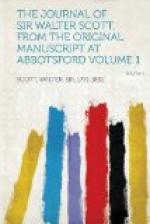April 7.—We visited the Castle in the morning. It is inhabited by a brother-in-law of the proprietor; and who is the proprietor? “Why, Mr. Robbins,” said the fat housekeeper. This was not a name quite according with the fine chivalrous old hall, in which there was no small quantity of armour, and odds and ends, which I would have been glad to possess. “Well, but madam, before Mr. Robbins bought the place, who was the proprietor?” “Lord Charles Townshend, sir.” This would not do neither; but a genealogy hanging above the chimney-piece informed me that the Ferrars were the ancient possessors of the mansion, which, indeed, the horseshoes in the shield over the Castle gate might have intimated. Tamworth is a fine old place, neglected, but, therefore, more like hoar antiquity. The keep is round. The apartments appear to have been modernised tempore Jac. I’mi. There was a fine demipique saddle, said to have been that of James II. The pommel rose, and finished off in the form of a swan’s crest, capital for a bad horseman to hold on by.
To show Anne what was well worth seeing, we visited Kenilworth. The relentless rain only allowed us a glimpse of this memorable ruin. Well, the last time I was here, in 1815,[160] these trophies of time were quite neglected. Now they approach so much nearer the splendour of Thunder-ten-tronckh, as to have a door at least, if not windows. They are, in short, preserved and protected. So much for the novels. I observed decent children begging here, a thing uncommon in England: and I recollect the same unseemly practice formerly.
We went to Warwick Castle. The neighbourhood of Leamington, a watering-place of some celebrity, has obliged the family to decline showing the Castle after ten o’clock. I tried the virtue of an old acquaintance with Lord Warwick and wrote to him, he being in the Courthouse where the assizes were sitting. After some delay we were admitted, and I found my old friend Mrs. Hume, in the most perfect preservation, though, as she tells me, now eighty-eight. She went through her duty wonderfully, though now and then she complained of her memory. She has laid aside a mass of black plumes which she wore on her head, and which resembled the casque in the Castle of Otranto. Warwick Castle is still the noblest sight in England. Lord and Lady Warwick came home from the Court, and received us most kindly. We lunched with them, but declined further hospitality. When I was last here, and for many years before, the unfortunate circumstances of the late Lord W. threw an air of neglect about everything. I believe the fine collection of pictures would have been sold by distress, if Mrs. Hume, my friend, had not redeemed them at her own cost.[161] I was pleased to see Lord Warwick show my old friend kindness and attention. We visited the monuments of the Nevilles and Beauchamps, names which make the heart thrill. The monuments are highly preserved. We concluded the day at Stratford-upon-Avon.




